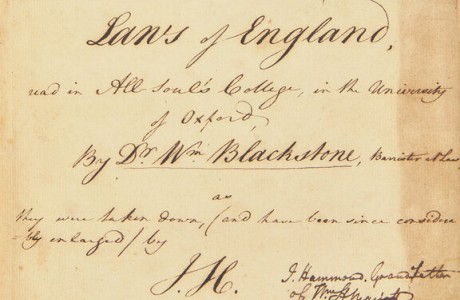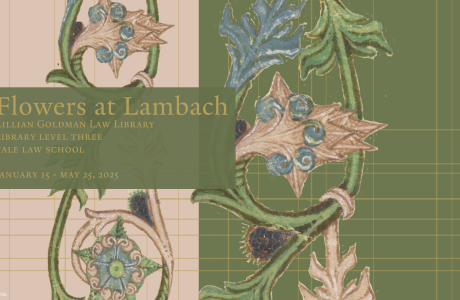Monuments of Imperial Russian Law: Medieval Origins
 Iaroslav I (c. 978-1054), Russkaia Pravda. [Bound with:] Ivan IV, the Terrible (1530-1584), Note on the Sudebnik of Tsar Ivan Vasil’evich. Russia, 18th century manuscript. Private Collection
Iaroslav I (c. 978-1054), Russkaia Pravda. [Bound with:] Ivan IV, the Terrible (1530-1584), Note on the Sudebnik of Tsar Ivan Vasil’evich. Russia, 18th century manuscript. Private Collection
Virtually all surviving documents from the Kievan period of early Russian and Ukrainian history are legal texts of one kind or another. The earliest are peace treaties concluded between Kievan Rus and Byzantium in or about 907, 911, 944, and 971. The supposition is compelling that the Slavic peoples inhabiting the lands of what became Kievan Rus had rules for interpersonal and interclan or intertribal behavior long before Kievan princes consolidated their authority.
The Russkaia Pravda (also known as Lex Russica) is the earliest surviving compilation of Russian laws. Whether it is a creative codification or a reduction of customary law to written form continues to be debated. So too does the extent to which the substance of the Russkaia Pravda, which contains striking parallels with aspects of Frankish and Anglo-Saxon law, was the result of mutual influence or an independent development.
No contemporary versions of the Russkaia Pravda survive; there are only three texts prior to the fifteenth century and ninety-two texts dating from the sixteenth to the eighteenth centuries. The traditional approach is to consider that there exist three versions of a single law (Russkaia Pravda, Expanded Pravda Russkaia, and Short Pravda Russkaia), but it is conceivable that each version may comprise an autonomous enactment. The initial version, believed to date from the reign of Iaroslav the Wise, began with the rules of blood feud, which the Expanded version relates was abolished by Iaroslav’s sons and replaced by a system of monetary compositions. Matters addressed were stealing, interest, custody of property, suits for money, shipwreck, beekeeping, succession, oaths, slavery, and ownership. The versions suggest that the Prince’s court played a minor role in prosecution and litigation. The system relied upon party initiative; there were no permanent judges, merely officials who presided over proceedings. There was no appeal, no systems of courts, no legal profession, no legal commentaries. Nor can we be certain of the territorial jurisdiction of the Russkaia Pravda.
In the manuscript exhibited here the Russkaia Pravda is accompanied by commentary on what has been called the first national Russian law code, the Sudebnik of 1497, here represented by an expanded and polished version from 1550. The Sudebniks are essentially manuals of procedure and to some extent of criminal law. The few articles devoted to civil law may reflect the inability of the compilers to consolidate satisfactorily the diversity of local rules. The extent to which the Sudebniks created new rules of procedure or embodied pre-existing patterns is much debated. The evidence of judgment charters prior to 1497 suggests that the transition to a vertical system of justice with a hierarchy of courts and judges was a gradual process rather than an innovation in 1497. The 1550 Sudebnik is known only through forty later copies, of which thirteen are of the sixteenth century. The text was adopted with the participation of the Boyar Duma in 1550 and confirmed by the Stoglav Assembly in 1551. Consisting of 99 or 100 articles, depending upon which copy is consulted, this document had no official title. The 1550 Sudebnik lay the foundations of a Russian administrative system at the central and local levels, reflecting the enhanced stature of the Tsar and the further centralization of power in Russia.
On exhibition is a previously unrecorded 18th-century manuscript of the short version of the Russkaia Pravda and the 1550 Sudebnik, with notes by V.N. Tatishchev (1686-1750), regarded by some as the first proper historian in Russia. He began editing the Russkaia Pravda in 1738, but it was published for the first time in Russia only in 1786, long after his death. Five other manuscript versions of the short version of the Russkaia Pravda are known with Tatishchev notes, all from the eighteenth century and all held by St. Petersburg institutions. The version exhibited here differs from the printed authoritative text in the numbering of clauses and in the precise text of the Tatishchev notes.
See: W.E. Butler, Russian Law (3d ed. 2009), Chapter 2; D.H. Kaiser, The Growth of Law in Medieval Russia (1980); D.H. Kaiser, The Laws of Rus’: Tenth to Fifteenth Centuries (1992).
“Monuments of Imperial Russian Law,” curated by William E. Butler and Mike Widener, is on display Mar. 1 - May 25, 2012, in the Rare Book Exhibition Gallery, Level L2, Lillian Goldman Law Library, Yale Law School.


